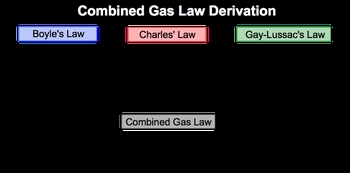Now we have the combined gas law. The combined gas law was created from combining Boyle's law, Charles' law, and Gay-Lussac's law. We're going to say it highlights the relationship between the variables of pressure, volume, and temperature. Remember, Boyle's law states that pressure is inversely proportional to volume. Charles' law states that volume is directly proportional to temperature, and Gay-Lussac's law states that pressure is directly proportional to temperature.
If we take a look down here, we can figure out how the combined gas law was derived. So it comes from combining Boyle's law, Charles' law, and Gay-Lussac's law. If we look, we have pressure and volume as numerators. Volume here is a numerator for Charles' law and Gay-Lussac's law have as their denominators, temperature. So that comes down here.
So here we'd say that the combined gas law is pvt = k, where k would be a constant. This here would represent our combined gas law.
And if we're dealing with 2 sets of pressures, volumes, and temperatures, then it can go further and say p1v1t1 = p2v2t2. So this is how the combined gas law can be derived from these earlier chemistry gas laws.


